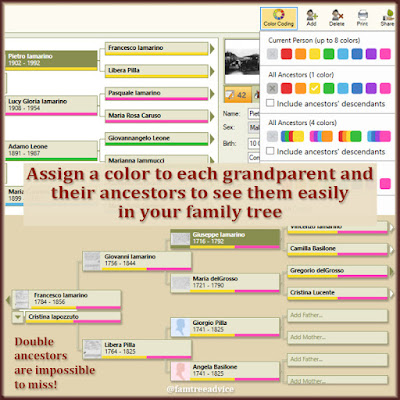I can never find obituaries for my ancestors. No marriage notices, no social events, nothing! Even so, when Newspapers.com had a membership sale, I signed up so I could do research for others.
But first I remembered an event in my life I wanted to look up. Of course the right local newspaper isn't available on Newspapers.com. I was off to a terrific start! Switching gears, I started looking for U.S. obituaries of anyone who came from my Grandpa's town in Italy. I did that by searching for his exact town name.
 |
| When names won't work, try an obituary search for your ancestral hometowns. |
You know how genealogists joke about their love of cemeteries? Well, this ghoulish game is perfect for us. The idea is to see if you can take a total stranger's obituary and find their place in your family tree.
After a couple of misses I found Mary. She was born in Colle Sannita in 1880 and died in Pennsylvania in 1970. Her obituary includes both her parents' names. It also says her husband Tony (also from Colle Sannita) had died only 3 weeks earlier. Of course I looked up his obituary, too.
Now comes the challenge. Could I fit this couple—both completely unknown to me—into my family tree?
I started with Mary whose maiden name they misspelled in the obituary. I knew it was wrong because I know the names from Grandpa's town like the back of my hand. I searched my collection of the town's vital records and found her birth record. I soon realized she was already in my tree with a complex in-law type of relationship to me. I even had her husband Tony's name in my tree based on 2 things:
- their son's 1914 birth record from the town, and
- a marriage notation in the column of her birth record.
Mary's Italian birth record had Tony's full name written in the column. I'd expected to find his birth record with her name on it. But there was no record for any Tony with Mary's name on it. So he's been a dead end for some time.
To figure out which birth record was his, I searched for the parents mentioned in his 1970 obituary. I had to be careful that I had exactly the right parents in this town where names repeat a LOT. So I searched for all the children born to a couple with the right names, Damiano and Maddalena. Finally I found a child born at a time when the birth records were far more detailed. This one record included the names of Damiano and Maddalena's fathers. That was the clue I needed to be sure I'd truly found the right couple.
 |
| I had no idea what became of the 1880s–1890s babies in my family tree. |
In the end, Tony became my 5th cousin 3 times removed. He was a dead end until I happened upon his wife's obituary. Now he's a distant cousin who shares my 7th great grandparents. Recently, I've been using the earliest records from Grandpa's town to fit more families together. But when I get to the later documents, many people will become dead ends for me. I can't know who left for another country or who they married.
A targeted search for your ancestor's town may tie together lots of loose ends in your family tree. For me, this is a great tool for discovering who left Italy, who they married, and what kind of life they lived.
Don't have access to a website like Newspapers.com? Prepare yourself to play this game the next time they offer a free weekend. Maybe this Memorial Day!



